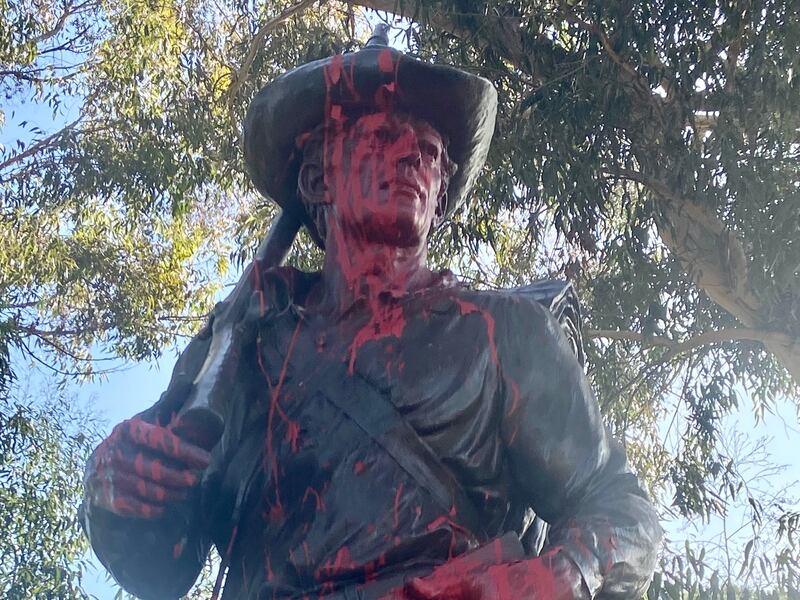This article was first published as the ChurchBeat newsletter. Sign up to receive the newsletter in your inbox weekly.
The red paint splashed on the face of a statue of a Mormon Battalion soldier and on the Book of Mormon in his left hand mark the third major episode of graffiti vandalism in three years of the monuments in Presidio Park in San Diego, California.
Last week, a vandal or vandals marred the statue, plaques and a mural dedicated to the only religiously oriented military unit in U.S. Army history. The monuments stand on city property in the Old Town section, above the official Mormon Battalion Historic Site maintained by The Church of Jesus Christ of Latter-day Saints.
“It’s the worst it has ever been,” said Dantzelle Allen, who with her husband Brad is completing their third and final year as leaders at the church’s historic site.





The monuments in the city park also have suffered multiple minor taggings in those three years, she said.
“It is amazing, we have never had a problem (at the official church site),” she added. “We have commented on that several times, how blessed we are.”
The graffiti included messages like “No thanks, no giving,” “May all colonizers fall,” and “Death to the White man’s world,” according to Fox5SanDiego.com.
Some initial work has been done to blank out those messages.
The statue of the soldier was completed and dedicated in 1969. The statue’s plaque says:
“This expedition helped win the war, prepared the way for colonization of the southwest, opened new trade routes and strengthened distant national boundaries.”
Cleaning the graffiti from the monuments will be expensive and time-consuming.
“The city is aware of the damage caused by vandals at Presidio Park over the Thanksgiving holiday,” San Diego city spokesman Tim Graham said in a statement provided to the Deseret News. “While it’s unfortunate to see such destructive behavior on historic parkland, the Parks and Recreation Department will be working as quickly as possible to initiate a time-intensive and costly cleaning of the area, taking extra care to ensure any graffiti abatement doesn’t disturb the historic integrity of the monuments at this site.”
The Mormon Battalion’s arrival in San Diego completed the longest infantry march in history. The battalion consisted of 500 troops and nearly 80 women and children who started out from Council Bluffs, Iowa, where Latter-day Saints were gathering to leave the United States.
The battalion’s government payroll helped Brigham Young buy wagons and oxen for the first pioneer trek in 1847 to what now is Utah.
The Mormon Battalion’s march began in July 1846 and arrived in San Diego on Jan. 29, 1847. The troops then built the first kiln in California and the city’s first water pumps, blacksmith shop and bakery.
One of the plaques at the site describes the historic nature of the battalion:
“The historic march of the Mormon Battalion — more than 2,000 miles through the wilderness — was made in fulfillment of U.S. Army orders. Brigham Young, prophet-leader of the Mormons, personally recruited these troops. The Battalion blazed the first wagon trail to the Pacific over the southern route, was instrumental in acquiring the vast southwestern empire for the United States and raised the stars and stripes for the first time over Fort Tucson and Fort Moore. Later some of these men helped in the discovery of gold at Sutter’s Mill while working their way back to Salt Lake City to rejoin Brigham Young and their families. Lt. Col. P. St. George Cooke, not a Mormon, praised his men, saying ‘History may be searched in vain for an equal march of infantry.’”
My recent stories
BYU students stand, cheer as Rev. Dr. William Barber II calls for a moral march on Washington (Nov. 30)
What I’m reading
Here’s what David Archuleta wants you to know about his faith journey.
Baptism is getting wild, according to this New York Times story that includes photos of evangelical baptisms it says are happening more often out of doors or in unique indoor circumstances.
To read more about the Mormon Battalion, consult this comprehensive list of books and articles.
If you like to read good magazine profiles, here’s one about the Rev. Dr. William Barber II, whose speech at BYU I covered on Tuesday. This is written by a Columbia journalism professor for the New Yorker and is exceptionally well done.
The painful broken ankle that ended a BYU football player’s season also postponed his wedding.
Officials at the University of Southern California apologized after USC’s student section conducted an obscene chant aimed at Latter-day Saints during its game with BYU last weekend — even though USC’s quarterback is a Latter-day Saint. Our Hal Boyd points out the long association between the church and USC.
Some smart national thinkers believe the American benefits system would be better off if it were modeled after the church’s Welfare Square in Salt Lake City.
My wife and I are enjoying “The Boys: A Memoir of Hollywood and Family,” by Ron and Clint Howard. So far, it’s been fun to learn about how they became child acting stars. Here’s one review of the book.
I found this a smart primer about the slang used by white supremacy groups and how it plays into their strategies to mislead people.


 alt=Tad Walch
alt=Tad Walch


